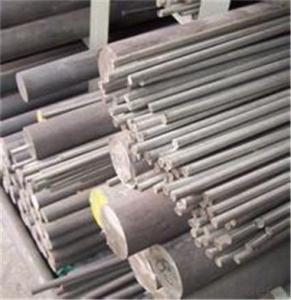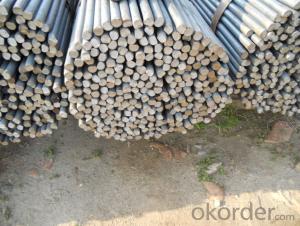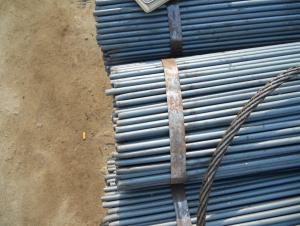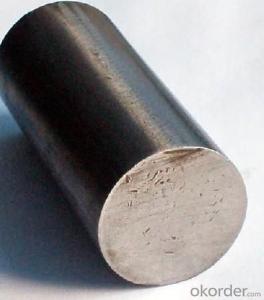Steel Round Bar 12L14 1214 1215 Free Cutting in China
- Loading Port:
- Tianjin
- Payment Terms:
- TT OR LC
- Min Order Qty:
- 90 m.t.
- Supply Capability:
- 2000000 m.t./month
OKorder Service Pledge
OKorder Financial Service
You Might Also Like
Description of steel round bar:
Is used mainly for force for small size and finish requirement strict instruments and meters, watch parts, automobile, machine tool and other kinds of machines used, strict with dimension precision and smooth finish, and the mechanical performance requirements are relatively low standard parts, such as gear, shaft, bolts, valves, bushing, pin, tube connectors, spring cushion, machine screw, plastic molding, procedures of surgical and dental appliances, etc.
Festures of steel round bar:
4340 Forged Round Steel Bar have good tenacity,hot tirdness nature and definite wearable;empty quenching under lower Austenitic temperature condition.small distortion after heat-treatment and so on.
Specifications of steel round bar:
Description |
Carbon Steel Rod/Carbon Steel Bar,carbon steel rod,carbon steel shaft,mild steel bar, mild steel shaft,ms bar | |
Material | ASTM | 1005,1006,1008,1010,1015,1020,1025,1030,1035,1040,1045,1050,1055,1060,1065,1070,1080,1084, 1016,1022 |
DIN | Ck10,Ck15,Ck22,Ck25,Ck30,Ck35,Ck40,Ck45,Ck50, 30Mn4,40Mn4 | |
BS | 040A04,095M15,045M10,080A40,045M10,080M50 | |
Standard | GB/T799,ASTM A29,A108,A321,A575,BS970,DIN1652,JIS G4051 | |
Section shape |
Round | |
Length |
As your required | |
Application | Carbon steel rod applies to chemical industry, shipping industry, | |
Images of steel round bar:

FAQ:
1. What is your package?
Packing situation: standard seaworthy packing or as customer required.
2. How long is the lead time?
Delivery time: 45 days after order confirmed.
- Q:Can steel round bars be used in the agricultural machinery industry?
- Yes, steel round bars can be used in the agricultural machinery industry. Steel round bars are known for their strength, durability, and versatility, making them suitable for various applications, including the agricultural machinery industry. These bars can be used to manufacture various components such as shafts, axles, gears, and connecting rods, which are essential for agricultural machinery. The high strength of steel ensures that these components can withstand the heavy loads and harsh conditions often encountered in agricultural operations. Additionally, steel round bars can be easily machined and welded, allowing for customization and efficient production of agricultural machinery parts. Overall, steel round bars are a reliable and cost-effective choice for the agricultural machinery industry.
- Q:How do you calculate the weight of a steel round bar based on its length and volume?
- To calculate the weight of a steel round bar based on its length and volume, you need to know the density of the steel. The density represents the amount of mass per unit volume of the material. The formula to calculate the weight is: Weight = Volume × Density First, you need to calculate the volume of the steel round bar. The volume of a cylinder (which is the shape of a round bar) is given by the formula: Volume = π × (Radius)^2 × Length Where π is a mathematical constant approximately equal to 3.14, and Radius is the radius of the round bar. Once you have the volume, you can multiply it by the density of the steel to find the weight. The density of steel can vary depending on the specific type of steel being used. For example, the density of mild steel is around 7850 kg/m³. Therefore, the weight of the steel round bar is calculated as: Weight = Volume × Density For example, let's say we have a steel round bar with a length of 1 meter and a radius of 0.5 meters. To calculate the weight, we need to find the volume first: Volume = π × (0.5)^2 × 1 Volume = 0.7854 m³ Next, we multiply the volume by the density of steel: Weight = 0.7854 m³ × 7850 kg/m³ Weight = 6171.79 kg So, the weight of the steel round bar would be approximately 6171.79 kg.
- Q:What are the different types of surface treatments for steel round bars?
- There are several different types of surface treatments available for steel round bars, each with its own benefits and applications. Some of the most common surface treatments for steel round bars include: 1. Galvanization: This process involves coating the steel round bars with a layer of zinc, which provides excellent corrosion resistance. Galvanized steel round bars are commonly used in outdoor and marine applications. 2. Black oxide coating: This treatment involves chemically converting the surface of the steel round bars to a black iron oxide layer. It provides increased corrosion resistance and a visually appealing black finish. Black oxide coated steel round bars are often used in decorative applications. 3. Grinding: Grinding is a surface treatment that involves removing the outer layer of the steel round bars through abrasive materials. This process improves the surface finish of the bars, making them smoother and more aesthetically pleasing. 4. Shot blasting: In shot blasting, small metallic or non-metallic particles are propelled at high velocity onto the surface of the steel round bars. This treatment removes mill scale, rust, and other impurities, resulting in a clean and uniform surface. 5. Chrome plating: Chrome plating involves depositing a layer of chromium onto the surface of the steel round bars. This treatment provides excellent corrosion resistance and a polished, mirror-like finish. Chrome plated steel round bars are commonly used in applications where aesthetics and corrosion resistance are important. 6. Powder coating: Powder coating is a process where a dry powder is applied electrostatically to the steel round bars and then cured under heat. This treatment creates a durable and attractive finish, offering resistance to corrosion, chemicals, and UV rays. 7. Passivation: Passivation is a chemical treatment that removes iron and other contaminants from the surface of steel round bars, leaving a clean and corrosion-resistant layer. This treatment is commonly used in the medical and food industries, where cleanliness and corrosion resistance are crucial. These are just a few examples of the various surface treatments available for steel round bars. The choice of treatment depends on the specific requirements of the application, such as corrosion resistance, aesthetics, and durability.
- Q:Can steel round bars be polished?
- Indeed, it is possible to polish steel round bars. The act of polishing steel round bars encompasses the utilization of abrasive substances, for instance, sandpaper or polishing compounds, to eliminate any flaws or coarse areas on the bar's exterior. This procedure can be executed manually or with the aid of machinery exclusively devised for polishing metals. Ultimately, a sleek and lustrous surface is achieved on the steel round bar. Nevertheless, it is imperative to acknowledge that the specific polishing methods and materials needed are contingent upon the type of steel and the desired end result.
- Q:What are the advantages of using chromium-alloy steel round bars?
- There are several advantages to using chromium-alloy steel round bars. Firstly, the presence of chromium in the alloy significantly enhances the corrosion resistance of the steel, making it ideal for applications in harsh environments or exposed to corrosive substances. Additionally, chromium-alloy steel round bars offer excellent strength and hardness, making them suitable for heavy-duty applications that require high load-bearing capacity. The inclusion of chromium also improves the steel's heat resistance, allowing it to withstand high temperatures without losing its structural integrity. Lastly, chromium-alloy steel round bars are known for their excellent wear resistance, making them a reliable choice for industries such as automotive, construction, and manufacturing.
- Q:What are the different types of steel round bar finishes for decorative purposes?
- For decorative purposes, steel round bars can be finished in various ways, each offering a unique appeal. These finishes not only enhance the overall appearance of the steel round bar but also make it suitable for a range of decorative applications. Here are some of the most popular finishes: 1. Achieving a polished finish involves using abrasives to polish the steel round bar, resulting in a smooth and shiny surface. This reflective, mirror-like finish adds an elegant and sophisticated touch to any decorative project. 2. A brushed finish, also referred to as a satin finish, is obtained by brushing the steel round bar with a fine abrasive material, creating a textured pattern. It offers a slightly matte appearance, making it perfect for contemporary or industrial-style decorative applications. 3. The hammered finish involves striking the steel round bar with a hammer, resulting in a textured and hammered surface. This finish creates a rustic and aged look, making it ideal for decorative items with a vintage or antique-inspired theme. 4. The blackened finish is achieved by subjecting the steel round bar to a chemical or heat treatment, resulting in a darkened or blackened appearance. It adds a sleek and modern touch to decorative projects, making it a popular choice for contemporary designs. 5. Powder coating is a durable and long-lasting finish where a powdered paint is electrostatically applied to the steel round bar and then cured under heat. This finish offers a wide range of color options and excellent protection against corrosion, making it suitable for both indoor and outdoor decorative applications. These examples illustrate the variety of steel round bar finishes available for decorative purposes. The choice of the finish depends on the desired aesthetic, style, and overall theme of the decorative project.
- Q:Which steel wire is the same diameter as round steel more resistant to breaking?
- A wire rope is a flexible rope twisted with a plurality of strands or strands of fine steel wire. The wire rope is twisted by multi-layer steel wires and then twisted by a certain number of strands into a spiral rope at the center of the rope core. In material handling machinery, for lifting, traction, tensioning and loading purposes. The wire rope has the advantages of high strength, light weight, stable work, easy breaking and whole breaking, and reliable work.
- Q:Can steel round bars be used for making oil and gas industry components?
- Yes, steel round bars can be used for making oil and gas industry components. Steel round bars are commonly used in the oil and gas industry due to their high strength, durability, and resistance to corrosion. These components require materials that can withstand harsh environments, high pressures, and extreme temperatures, and steel round bars meet these criteria. They are commonly used to manufacture various components such as valves, flanges, pipes, and fittings, which are vital for the functioning of the oil and gas industry. Additionally, steel round bars can be easily machined and welded, allowing for the fabrication of complex shapes and structures required in this industry. Overall, steel round bars are a reliable and widely used material for making oil and gas industry components.
- Q:How do you calculate the moment of inertia for a steel round bar?
- To calculate the moment of inertia for a steel round bar, you can use the formula for the moment of inertia of a solid cylinder. The moment of inertia, usually denoted as I, represents the resistance of an object to changes in its rotation. The formula for the moment of inertia of a solid cylinder is: I = (1/2) * m * r^2 Where: - I is the moment of inertia - m is the mass of the cylinder - r is the radius of the cylinder To calculate the moment of inertia for a steel round bar, you need to know the mass and the radius of the bar. The mass can be determined by multiplying the density of steel by the volume of the cylinder. The volume of a cylinder is given by the formula: V = π * r^2 * h Where: - V is the volume - r is the radius - h is the height or length of the round bar Once you have the mass and the radius, you can substitute these values into the formula for the moment of inertia to calculate it. Remember to convert the units to be consistent (e.g., if the radius is given in centimeters, convert it to meters). It is important to note that the moment of inertia calculated using this formula assumes that the steel round bar is a solid cylinder. If the bar has a different shape or has hollow sections, you will need to consider those factors in your calculation.
- Q:How do steel round bars compare to ceramic round bars?
- Steel round bars and ceramic round bars have distinct differences in terms of their properties and applications. Steel round bars are known for their exceptional strength and durability. They are made from alloys of iron and carbon, with additional elements such as manganese, chromium, and nickel. Steel bars are highly resistant to deformation, can withstand high temperatures, and have high tensile strength. Due to these properties, steel round bars are commonly used in construction, manufacturing, and engineering applications where strength and reliability are crucial. They are also easily machinable and can be shaped into various forms, making them versatile for different uses. On the other hand, ceramic round bars are made from non-metallic materials, such as clay, porcelain, or glass. Ceramics offer unique properties such as high resistance to heat, corrosion, and wear. They are also chemically inert and have excellent electrical insulation properties. Ceramic round bars are commonly used in applications where high temperatures, chemical resistance, or electrical insulation are required, such as in the aerospace industry or for manufacturing electronic components. When comparing steel round bars to ceramic round bars, it is important to consider the specific requirements of the application. Steel round bars are preferred for their exceptional strength and toughness, making them suitable for heavy-duty applications where mechanical stress and load-bearing capabilities are crucial. Ceramic round bars, on the other hand, are often chosen for their resistance to heat, chemicals, and electrical insulation properties, which are important in specialized industries. In summary, steel round bars and ceramic round bars have different properties and are suitable for different applications. Steel round bars are known for their strength and durability, making them suitable for heavy-duty applications, while ceramic round bars excel in high-temperature, chemical-resistant, and electrically insulating applications.
1. Manufacturer Overview |
|
|---|---|
| Location | |
| Year Established | |
| Annual Output Value | |
| Main Markets | |
| Company Certifications | |
2. Manufacturer Certificates |
|
|---|---|
| a) Certification Name | |
| Range | |
| Reference | |
| Validity Period | |
3. Manufacturer Capability |
|
|---|---|
| a)Trade Capacity | |
| Nearest Port | |
| Export Percentage | |
| No.of Employees in Trade Department | |
| Language Spoken: | |
| b)Factory Information | |
| Factory Size: | |
| No. of Production Lines | |
| Contract Manufacturing | |
| Product Price Range | |
Send your message to us
Steel Round Bar 12L14 1214 1215 Free Cutting in China
- Loading Port:
- Tianjin
- Payment Terms:
- TT OR LC
- Min Order Qty:
- 90 m.t.
- Supply Capability:
- 2000000 m.t./month
OKorder Service Pledge
OKorder Financial Service
Similar products
New products
Hot products
Related keywords































